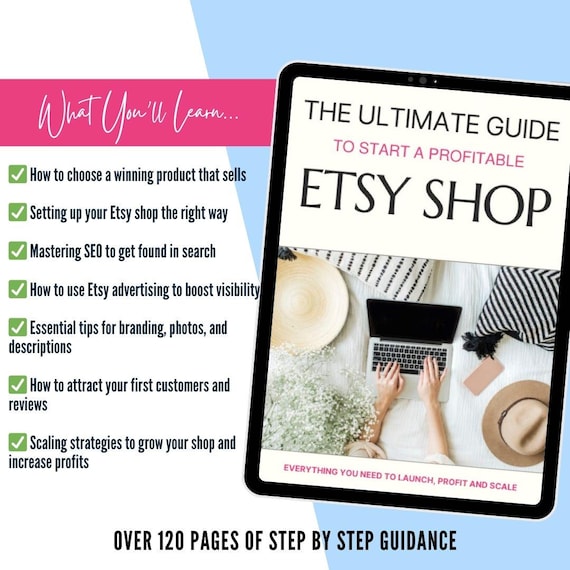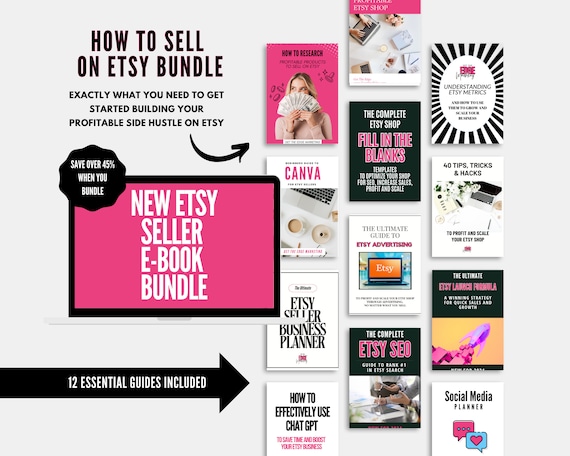Are you ready to turn your creative passion into a thriving business? Starting and scaling an Etsy shop might be your perfect solution.
Imagine crafting beautiful products that you love and seeing them reach customers worldwide. This guide is here to help you do just that. You’ll learn how to set up your shop, attract loyal customers, and grow your brand effectively. As you dive in, think about the excitement of making your first sale and the satisfaction of watching your shop flourish.
You’ll discover practical tips and strategies, designed to make your journey smoother and more rewarding. Whether you’re dreaming of financial independence or simply want a fulfilling side hustle, this guide will provide the steps to get there. Let’s unlock the secrets to a successful Etsy shop together, so you can transform your ideas into a thriving business that stands out in the marketplace. Are you ready to start crafting your success story?
Table of Contents
ToggleChoosing Your Niche
Selecting a niche is crucial for starting an Etsy shop. Focus on unique products that reflect your passion. This attracts the right audience and sets your shop apart.
Choosing the right niche for your Etsy shop is like setting the foundation of your business. A well-chosen niche not only helps you stand out but also attracts the right customers. Your niche should reflect both market demand and your personal interests.
Identifying Market Trends
To successfully choose a niche, start by looking at current market trends. Research popular categories on Etsy and other platforms. Are there any emerging themes that seem to be gaining traction? Utilize tools like Google Trends or Etsy’s own search bar to see what people are actively searching for. This gives you a clear idea of what customers are interested in right now. Remember, a trendy product today might not be popular tomorrow, so keep an eye on shifting interests. Check social media platforms for trending hashtags and discussions. This can be a goldmine for niche ideas. Are there any products that people can’t stop talking about?
Finding Your Passion and Skills
While trends are important, your niche should also align with your own passions and skills. What do you love to create? Your enthusiasm for your product will shine through and attract buyers. Think about your hobbies and talents. If you’re skilled at knitting, could you offer unique, handcrafted scarves? Your expertise will give you an edge over competitors. Consider what friends and family often compliment you on. Have they ever told you, “You should sell these!”? Sometimes, others see your potential before you do. Choosing a niche that balances market demand with your personal interests will set the stage for a thriving Etsy shop. Are you ready to turn your passion into profit?
Setting Up Your Shop
Setting up your Etsy shop is like laying the foundation for your creative business. It’s the first step in your journey to becoming an online entrepreneur. You want to make a strong first impression with your shop’s appearance and branding. Let’s dive into the crucial steps to get your shop up and running.
Creating an Etsy Account
Start by visiting Etsy’s website and clicking on “Sign in” at the top right corner. You’ll see an option to register if you don’t have an account. Fill in your details, such as your name and email address. Make sure to choose a password that’s easy for you to remember but hard for others to guess.
Once you’ve created your account, explore the platform a bit. Familiarize yourself with the features and tools available. This will help you feel more confident as you start building your shop. Think of it as your digital storefront where your unique creations will shine.
Crafting a Memorable Shop Name
Your shop name is your brand’s identity. It’s often the first thing potential customers notice. Aim for a name that’s catchy but also reflects what you sell. Your shop name should be easy to spell and remember.
Imagine browsing through thousands of shops. Would your chosen name stand out? Test it with friends or family. Their feedback can be invaluable. Consider using descriptive words or a play on words to make your shop memorable.
Designing Your Shop Banner And Logo
Your shop banner and logo are visual representations of your brand. They set the tone for your shop’s aesthetic. Choose colors and fonts that align with your products and overall vibe. They should evoke the feeling you want your customers to have when they visit your shop.
Canva is a great tool for designing professional-looking graphics. You don’t need to be a graphic designer to create something stunning. Personalize your banner with images that showcase your best work. Make your logo simple yet distinctive.
Ask yourself: Does your shop look inviting? Would you want to browse through it if you were a customer? Keep your designs clean and coherent to make a lasting impression.
Product Listings
Starting an Etsy shop involves creating appealing product listings that grab attention. Focus on clear photos and detailed descriptions to attract buyers. Highlight unique features and benefits to make your items stand out.
Starting an Etsy shop is like embarking on a creative adventure. A crucial part of this journey is your product listings. They are your shop’s digital storefront and can make or break your success. How you present your products can significantly impact your visibility and sales. Let’s dive into three key areas that will help you create outstanding product listings: writing compelling descriptions, using high-quality photos, and pricing your products competitively.
Writing Compelling Descriptions
Your product description is your chance to tell a story. Use it to capture the essence of your item. Describe what makes your product unique, its benefits, and how it can fit into your customer’s life. Keep your sentences short and impactful. Use bullet points to highlight key features. Ask yourself: What problem does my product solve? Why should someone choose this over a competitor’s offering?
Using High-quality Photos
Photos are the first thing potential buyers notice. They need to be clear and vibrant. Invest time in taking photos that showcase your product from different angles. Natural lighting can make a world of difference. Experiment with backgrounds that complement your product without distracting from it. Consider: Would you buy an item based solely on the photo?
Pricing Your Products Competitively
Pricing is more than just numbers. It’s about positioning your product in the market. Research similar items on Etsy to gauge the pricing landscape. Factor in costs like materials, time, and shipping. Strike a balance that reflects your product’s value while remaining attractive to buyers. Think: Does my price reflect the quality and uniqueness of my product? By focusing on these areas, you’re not just listing products—you’re crafting an experience for your customers. Each detail counts, and your attention to them can transform casual browsers into loyal buyers.
Optimizing for Search
Optimizing your Etsy shop for search is crucial to attracting potential buyers and boosting sales. When you understand how search engines on Etsy work, you can leverage the power of SEO to make your products more visible. This means more eyes on your creations and ultimately more sales.
Understanding Etsy Seo
Etsy SEO is the process of improving your shop’s visibility in Etsy’s search results. It’s not just about using fancy words—it’s about understanding what your customers are searching for. Imagine knowing exactly what someone types into the search bar before they find your product. Wouldn’t that be powerful?
Etsy’s search algorithm considers relevance, quality, and customer satisfaction. This means your titles, tags, and descriptions must align with what buyers are looking for. When I started, I thought listing everything under the sun would do the trick. However, focusing on specific search terms that buyers actually use made a big difference.
Using Keywords Effectively
Keywords are the words and phrases that shoppers use to find products. Think like your customer. What would you type if you were searching for your product?
Use keywords in your product titles, tags, and descriptions. Don’t overstuff them; keep it natural. I found that using a mix of broad and specific keywords worked best. Broad keywords attract general buyers, while specific keywords target those who know exactly what they want.
Tagging Your Products
Tags are crucial for Etsy SEO. They help categorize your product and make it easier for buyers to find them. Use all the tags available to you—it’s like having multiple doors leading to your shop.
Choose tags that accurately describe your product. When I first started, I used irrelevant tags just to fill space. My products weren’t seen by the right audience. By focusing on relevant tags, I connected with buyers who were genuinely interested.
Ask yourself: are my tags helping buyers find my products? If not, it might be time for a change. Experiment and see what works; it’s all about finding the right match between your shop and potential customers.
Marketing Your Shop
Starting an Etsy shop is just the beginning. To succeed, marketing is essential. Effective marketing helps you reach more customers. It builds your brand’s presence online. Without it, your shop may go unnoticed. Let’s explore key strategies to market your Etsy shop effectively.
Leveraging Social Media
Social media connects you with potential buyers. Platforms like Instagram and Pinterest are great for Etsy sellers. Share high-quality photos of your products. Show how they fit into everyday life. Use engaging captions to tell your product’s story. Interact with followers to build relationships. Consistent posting keeps your audience engaged.
Building an Email List
An email list is a direct line to your customers. Offer a discount for signing up. This encourages visitors to subscribe. Share updates about new products and promotions. Keep your emails short and engaging. Personalize your messages to connect with your audience. Regular emails keep your shop in your customer’s mind.
Collaborating with Influencers
Influencers can expand your shop’s reach. Find influencers who align with your brand. They should have an engaged audience. Collaborate by sending them your products. Ask them to share honest reviews. Their endorsement can increase trust in your shop. Choose influencers carefully for genuine connections.

Credit: www.etsy.com
Providing Excellent Customer Service
Providing excellent customer service is the backbone of a successful Etsy shop. It’s not just about selling beautiful products; it’s about building relationships. When you treat your customers well, they become your best marketers, sharing their positive experiences with others. Let’s dive into how you can handle inquiries, manage returns, and encourage reviews effectively.
Handling Customer Inquiries
Quick response times are crucial. Answering questions promptly can turn a curious browser into a buyer. Keep your tone friendly and helpful; it sets the stage for a positive experience.
Use templates for common questions, but personalize them. Share a quick story about how a customer inquiry once led you to improve a product. It shows you’re listening and evolving.
Ask yourself, what impression do you want to leave? A single interaction can define your shop’s reputation, so make it count.
Managing Returns and Complaints
Returns and complaints can feel daunting, but they’re opportunities to build trust. Approach each situation calmly and with empathy. Offer solutions that align with your policies, but also consider the customer’s perspective.
Share how you handled a difficult return and turned it into a loyal customer relationship. This showcases your problem-solving skills and commitment to satisfaction.
Is your return policy clear? Ensure it’s easy to find and understand, reducing confusion and frustration for both sides.
Encouraging Customer Reviews
Positive reviews can elevate your shop’s credibility. Encourage reviews by making the process simple and thanking customers for their feedback.
Why not include a personal note with each order, inviting customers to share their thoughts? This small touch can increase engagement and show your appreciation.
Consider how reviews can help you improve. Constructive feedback is a goldmine for growth, so embrace it with an open mind.
Scaling Your Business
Learn how to expand your Etsy shop effectively with this beginner’s guide. Discover simple steps to increase sales and grow your audience. Craft a successful strategy to take your online store to new heights.
Scaling your Etsy shop can open up new opportunities. As your business grows, it’s essential to manage this growth effectively. Scaling requires thoughtful planning and strategic actions. Let’s explore some crucial steps to help your Etsy shop thrive.
Analyzing Sales Data
Look at your sales data regularly. Understand which products sell the best. Notice patterns in customer preferences. Analyze peak selling times. Use this data to make informed decisions. Adjust your inventory and marketing strategies based on these insights. This helps you meet customer demands efficiently.
Expanding Product Range
Consider adding more products to your shop. Diversifying your offerings can attract more customers. Think about complementary products that match your existing items. This increases the chance of repeat purchases. Also, test new designs or variations. Listen to customer feedback. It guides you in creating items they want to buy.
Exploring Additional Sales Channels
Expand beyond Etsy to reach more customers. Consider using platforms like Amazon Handmade or eBay. Each platform has its unique audience. Research where your products might fit best. Also, use social media to showcase your creations. Platforms like Instagram and Pinterest can drive traffic to your shop. Engage with your audience to build a loyal customer base.
Managing Finances
Managing finances is a crucial aspect of scaling your Etsy shop. Without a solid financial foundation, even the most creative and unique products can struggle to succeed. From tracking your expenses to understanding taxes, each element plays a vital role in your business’s growth and sustainability. Let’s dive into how you can effectively manage your shop’s finances, ensuring you’re not just making sales but also maximizing your profits.
Tracking Expenses and Revenue
Keep a detailed record of every penny spent and earned. This gives you a clear picture of your financial health. Use a simple spreadsheet or software like QuickBooks to track expenses such as materials, shipping, and marketing costs. Regularly update this to avoid surprises.
Consider setting aside time weekly to review your sales. Look at which products are selling well and which are not. This insight helps you make informed decisions about inventory and marketing strategies.
Ask yourself: Are there areas where you can cut costs or increase revenue? This question should guide your financial decisions. Sometimes, small tweaks can lead to significant savings or additional income.
Understanding Taxes and Fees
Taxes can be daunting, but knowing them is essential for your business. Familiarize yourself with sales tax requirements in your region, as these can affect pricing and profit margins.
Etsy charges fees for listing items and processing sales. It’s important to factor these into your pricing strategy. Aim to set prices that cover costs and generate a reasonable profit.
Seek advice from a tax professional if you’re unsure. They can offer guidance tailored to your shop’s needs, saving you time and potential headaches.
Budgeting for Growth
Growing your Etsy shop requires a strategic budget. Allocate funds for marketing campaigns and product development. These investments can fuel your shop’s expansion.
Consider creating a budget that accounts for seasonal changes in sales. During peak seasons, invest more in advertising to capitalize on increased consumer interest.
Prioritize savings for future projects or unexpected expenses. Having a financial cushion can prevent stress and keep your business on track.
Managing your shop’s finances isn’t just about crunching numbers; it’s about setting your business up for success. What steps will you take today to ensure your Etsy shop thrives tomorrow?
Staying Updated with Etsy Policies
Running an Etsy shop requires staying informed about Etsy’s policies. These guidelines help sellers maintain a fair and trusted marketplace. Ignoring these policies can lead to account issues or even suspension. Regularly checking for updates is crucial for every Etsy seller. Understanding and complying with Etsy’s policies ensure smooth operations and customer satisfaction.
Complying with Seller Guidelines
Etsy’s seller guidelines cover everything from product listings to shipping practices. Read these guidelines carefully and follow them to prevent violations. Accurate product descriptions and clear photos are essential for compliance. Provide honest details about your products to build trust with buyers. Also, ensure your shop policies align with Etsy’s rules.
Maintain transparent communication with your customers. Respond to inquiries promptly and professionally. This practice not only complies with Etsy’s standards but also improves your shop’s reputation. Regularly review your listings to ensure they adhere to Etsy’s current rules.
Keeping Up with Policy Changes
Etsy occasionally updates its policies to improve the platform. Stay informed about these changes by checking Etsy’s announcements regularly. Subscribe to Etsy’s newsletter for the latest updates. Understanding new policies helps you adapt quickly without disrupting your business.
Participate in Etsy’s forums and community discussions. These platforms provide insights into upcoming changes and how they might affect sellers. Networking with other sellers can offer valuable advice and support. Staying updated with Etsy policies is a continuous process that benefits your shop’s longevity and success.

Credit: www.etsy.com
Frequently Asked Questions
How to Scale Your Etsy Shop?
To scale your Etsy shop, optimize product listings with keywords, offer unique designs, and provide excellent customer service. Use social media to promote your shop, and consider investing in Etsy Ads for visibility. Continuously analyze your shop’s performance and adapt your strategies to increase sales and expand your customer base.
How Much Does Etsy Take from a $25 Sale?
Etsy charges a 6. 5% transaction fee on the sale price, which is $1. 63 for a $25 sale. Additionally, there’s a 3% plus $0. 25 payment processing fee, totaling $1. 00. Overall, Etsy takes $2. 63 from a $25 sale.
How Do I Start an Etsy Shop for Beginners?
Create an Etsy account and choose your shop name. List your products with clear photos and descriptions. Set pricing, shipping, and payment options. Optimize your shop for SEO with relevant keywords. Launch your shop and promote through social media and marketing strategies.
How Much Does Etsy Take from a $100 Sale?
Etsy charges a 6. 5% transaction fee on the item price. For a $100 sale, the fee is $6. 50. Additionally, there’s a 3% + $0. 25 payment processing fee, totaling $3. 25. Thus, Etsy takes $9. 75 from a $100 sale.
Keep in mind potential additional fees for shipping or listing.
Conclusion
Starting an Etsy shop can be exciting. Focus on your passion and creativity. Consistency is key to success. Always engage with customers. Listen to their feedback. Improve your products based on their needs. Good photos make a difference. Clear descriptions help buyers decide.
Use social media to promote your shop. Stay informed about market trends. Learn from other successful sellers. Be patient and persistent. Growth takes time and effort. Celebrate small victories along the way. Keep your goals in sight. Your Etsy journey can be rewarding.
Enjoy the process and keep learning.




